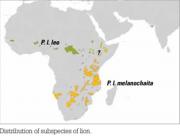In 2017, the Cat Classification Taskforce of the Cat Specialist Group revised felid subspecies, including for the lion, and they recognised 2 subspecies: the northern
Panthera leo leo for lions in Asia and northern parts of Africa (including the northern part of Central Africa), and the southern
Panthera leo melanochaita for lions in southern parts of Africa (including in East Africa), but there's a problem, if you look closely at their map of lion subspecies in Page 72:
https://repository.si.edu/bitstream/hand...=y#page=72

They put a question mark over Ethiopia in Northeast Africa, and said "There have been several recent molecular studies, which confirm that there is a clear divergence between the lions of eastern and southern Africa and those from the rest of range (e.g. Dubach et al. 2013, Barnett et al. 2014). Barnett et al. (2014) identify five phylogeographical groups, which have differentiated genetically from each other over the last c. 80,000 years. However, two of these groups are partly sympatric in southern Africa, making their recognition as separate subspecies inappropriate. The divergence of the other three groups, which range from Central and West Africa to India, has been very recent (c. 50,000 years ago or less). Asian lions, which have frequently been recognised as a distinct subspecies have only colonised SW Asia within the last 20,000 years. However, this is far earlier than the suggestion by Thapar et al. (2013) that lions were introduced to India from East Africa from the 17th Century by the Mughals. Mazák (2010) analysed craniometric variation, although some populations were poorly represented, e.g. West Africa, and found a broadly similar pattern of variation with the main differentiation in skull shape being between lions in southern and eastern Africa and those in the rest of the range. Bertola et al. (2011, 2016) have confirmed this basic pattern of differentiation into two subspecies based on genetic data; one from south and east Africa and one from the rest of the range.
The contact zone is somewhere in Ethiopia. On the basis of these recent studies, we recognise two subspecies,
although morphological diagnoses are currently unknown:
Panthera leo leo (Linnaeus, 1758). Distribution: Central and West Africa and India; formerly throughout North Africa, SE Europe, the Middle East, Arabian Peninsula, SW Asia.
Panthera leo melanochaita (Hamilton Smith, 1842). Distribution: Southern and eastern Africa."
To put it simply, according to the CSG, using the work of
Bertola et al. on lion genetics, the ranges of the northern (
P. l. leo) and southern (
P. l. melanochaita) lion subspecies meet at Ethiopia, and thus classifying Ethiopian lions (formerly
Panthera leo abyssinica or
Panthera leo roosevelti in honour of the U.S. President Theodore Roosevelt, who used to go hunting in Africa:
https://archive.org/stream/smithsonianmi...3/mode/2up) is difficult.
If you remember, Ethiopian lions at Addis Abeba Zoo had earlier been in the news for their genetic makeup, like in National Geographic, after Bruche
et al. (
https://link.springer.com/article/10.100...8-5#page-2) determined them to be "genetically distinct":
https://blog.nationalgeographic.org/2012...-is-found/
![]()
*This image is copyright of its original author
A lion discovered in Bale Mountains National Park,
National Geographic:
https://www.nationalgeographic.com.au/an...video.aspx
![]()
*This image is copyright of its original author
However, as per Bertola
et al. (
https://www.nature.com/articles/srep3080..._evolution), they're not alone, and this appears to be a reason why the Addis Abeba lions, despite being in East Africa, were found to be different to wild lions in that region, such as Tanzania:
![]()
*This image is copyright of its original author
![]()
*This image is copyright of its original author
![]()
*This image is copyright of its original author
According to Bertola
et al., the Horn of African country of Ethiopia, part(s) of Somalia or Somaliland (from where
Panthera leo somaliensis or
Panthera leo webbiensis was described:
https://web.archive.org/web/201707281311...ra_leo.pdf), and possibly northern parts of Kenya and Uganda (from where
Panthera leo nyanzæ was described:
https://archive.org/stream/smithsonianmi...5/mode/2up) in East Africa, and the southeastern part of South Sudan, are where the northern and southern lion groups overlap. In addition, the ranges of the 2 groups are depicted as being close in the northeastern part of D. R. Congo, from where
Panthera leo azandicus was described:
https://archive.org/stream/bulletinameri...3/mode/2up
A lion in Somaliland / Somalia in the Horn of Africa, photo by Feisal Omar of Reuters:
https://www.businessinsider.com/the-self...of-china-1
![]()
*This image is copyright of its original author
Northeast Congolese lion (formerly
Panthera leo azandica) at Virunga National Park, photo by Adrian Treves:
https://savevirunga.com/2012/07/02/1-000...irunga-10/
![]()
*This image is copyright of its original author
Ugandan lion (formerly
Panthera leo nyanzæ) in Murchison Falls National Park, adjacent to Virunga Park, photo in
Mariana Tourist Hotel:
https://marianahthotel.wordpress.com/saf...onal-park/
![]()
*This image is copyright of its original author
Another northern Ugandan lion in Kidepo Valley National Park, just south of South Sudan, photo in
Ultimate Expeditions:
https://ultimateexpeditions.com/kidepo-v...ional-park ![]()
*This image is copyright of its original author
South Sudanese lion at Boma National Park, photo in Pinterest:
https://www.pinterest.com/pin/570760952752139229/
![]()
*This image is copyright of its original author
Counting northern Kenyan lions, by the
Lion Recovery Fund:
https://www.lionrecoveryfund.org/project...de-survey/
![]()
*This image is copyright of its original author





















